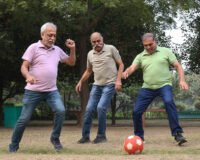Choosing among senior citizen homes is a big decision for anyone—but it’s especially important if you live with diabetes. The right community can make daily care feel simple and sustainable; the wrong fit can leave you chasing meals, meds, and monitoring. Use this practical guide to evaluate whether a residence truly supports diabetes-friendly living—then see how Saral Satya Legacy (SSL) brings those essentials together.
1) Medical Readiness: Care That Matches Your Routine
Start with the basics: does the community understand diabetes management beyond buzzwords?
- Medication support: Ask how staff help with timing, dosing reminders, and safe storage (refrigeration for insulin, etc.).
- Monitoring: Check whether residents can use their own glucometers/CGMs, how data is tracked, and whether staff can escalate patterns (e.g., frequent morning lows).
- Clinical network: Confirm tie-ups with nearby clinics, labs, and hospitals; ask about response time for urgent care, and whether transport is on call.
2) Dining That Works With (Not Against) Your Blood Sugar
Food is the foundation. You want meals that are balanced, predictable, and satisfying.
- Menu structure: Look for steady meal timing, consistent carb patterns, and whole-food emphasis.
- Customization: Can they tweak portions or swap sides (millet/whole wheat instead of refined grains)? Is a protein add-on easy to request?
- Nutrition transparency: The best kitchens share ingredient lists and can discuss macro balance for your typical plate.
- Snacks: Are smart snacks (curd, eggs, sprouts, nuts, roasted chana, fruit) available instead of only sugary or refined options?
At Saral Satya Legacy, meals are designed under the guidance of nutritionists and dieticians. Each day’s menu aims to be balanced, healthy, and nutritive—keeping in mind how common diabetes and hypertension are in older age. Specific requirements can be accommodated on a case-by-case basis, so your plate matches your plan rather than forcing you to compromise.
3) Movement & Lifestyle: Easy Ways to Stay Active
Activity is the most reliable “medicine” without a prescription. Evaluate a community’s built-in prompts:
- Daily movement: Safe walking paths, step challenges, or strolls after meals to smooth post-meal spikes.
- Strength & balance: Light resistance classes, physiotherapy-led sessions, and chair-based options if mobility is limited.
- Low-impact cardio: Options like stationary cycling or water-based work (if available) are joint-friendly and sugar-smart.
- Social motivation: Group routines make consistency fun—and consistency is what improves numbers.
If you’re touring, ask to sit in on a class or peek at the monthly activity calendar.
4) Safety for Highs and Lows
Even well-managed diabetes has off days. The right senior citizen homes prepare for both directions:
- Hypoglycemia readiness: Are fast-acting carbs (glucose tablets/juice) available? Do staff know the signs and steps?
- Hyperglycemia response: Is there a hydration and monitoring protocol? Can a nurse check ketones if needed?
- Night-time checks: If you’re prone to nocturnal lows or need help at odd hours, confirm how to call and how quickly help arrives.
Clarity here is peace of mind—for you and your family.
5) Tech, Data, and Communication
Modern diabetes care is smoother with simple tech:
- Device-friendly policies: Charging stations, safe storage, and a place to sync CGM data if you use one.
- Record keeping: How are readings and incidents logged? Can summaries be shared with your physician?
- Family updates: Opt-in systems so loved ones get timely, relevant updates without micromanaging your day.
6) Environment & Routine: The “Feel” Test
Look beyond checklists:
- Consistency: Do meals arrive on time? Are activities actually happening or just posted on a board?
- Staff warmth: Are reminders respectful? Do they encourage—not police—your routine?
- Resident stories: Ask current residents how the home has supported their health goals.
If the daily rhythm feels calm and reliable, diabetes management usually does too.
Why Saral Satya Legacy Stands Out
SSL blends medical readiness, food quality, and lifestyle design:
- Nutrition-led dining: Menus crafted with nutritionists and dieticians for balance and steady energy.
- Case-by-case accommodations: Extra protein, portion swaps, and culturally familiar dishes made sugar-smart.
- Wellness ecosystem: Yoga, group physiotherapy, walking clubs, and strength sessions scaled for comfort and safety.
- Care pathways: Medication reminders, monitoring support, and coordinated referrals when needed—without taking away your independence.
If you’re comparing senior citizen homes, add SSL to your shortlist and experience how small daily details add up to stable numbers and a better quality of life.
Conclusion
The best senior citizen homes don’t just “allow” diabetes management—they make it easier. Look for clear medical protocols, protein-forward and customizable meals, movement built into the day, and staff who communicate with kindness and competence. At Saral Satya Legacy, nutrition-led dining and thoughtful routines help residents live well with diabetes—without constant worry or complex workarounds. When your environment supports your plan, you can focus on what matters: enjoying your days, your hobbies, and your community.
FAQs
1) Will I lose independence if the staff help with diabetes care?
No. Good support systems work in the background—timely reminders, smart meals, and quick assistance—so you stay independent while feeling safer.
2) Can the kitchen handle both vegetarian and non-vegetarian diabetes-friendly meals?
Although the in-house kitchen of SSL is vegetarian, we have arrangements in place to obtain non-vegetarian food from a certified kitchen. One can order from designated vendors as well and have non veg in their respective rooms also.
3) What should I bring when I move in?
Your recent prescriptions, medication schedule, glucometer/CGM and supplies, a doctor’s note on targets/sick-day plans, and a short list of food preferences or allergies.





